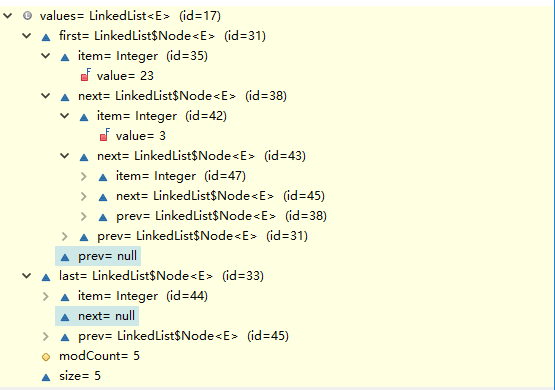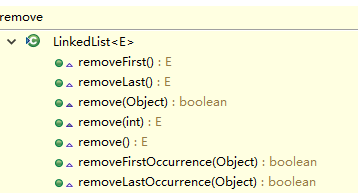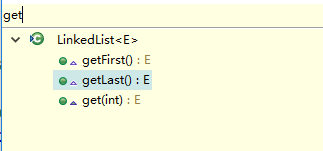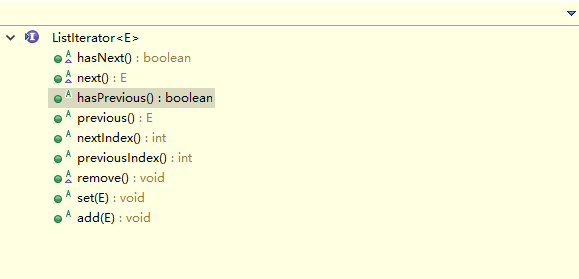本文简单分析一下JDK1.7的LinkedList源码,看一下其内部的结构以及典型方法的实现~
LinkedList内部结构
查看LinkedList的源码,发现其继承自AbstractSequentialList,实现了List,Deque,Cloneable以及Serializable接口,如:
public class LinkedList<E> extends AbstractSequentialList<E> implements List<E>, Deque<E>, Cloneable, java.io.Serializable { }
也就意味着:
- LinkedList 是一个继承于AbstractSequentialList的双向链表。它也可以被当作堆栈、队列或双端队列进行操作。
- LinkedList 实现 List 接口,能对它进行列表操作。
- LinkedList 实现 Deque 接口,即能将LinkedList当作双端队列使用。
- LinkedList 实现了Cloneable接口,即覆盖了函数clone(),能克隆。
- LinkedList 实现java.io.Serializable接口,这意味着LinkedList支持序列化,能通过序列化去传输。
public class LinkedList<E> extends AbstractSequentialList<E> implements List<E>, Deque<E>, Cloneable, java.io.Serializable { transient int size = 0; /** * Pointer to first node. * Invariant: (first == null && last == null) || * (first.prev == null && first.item != null) */ transient Node<E> first; /** * Pointer to last node. * Invariant: (first == null && last == null) || * (last.next == null && last.item != null) */ transient Node<E> last; }
从上述代码可以看出,LinkedList中有size,first以及last全局变量,其作用分别是:
size -- 存放当前链表有多少个节点。
first -- 指向链表的第一个节点的引用
last -- 指向链表的最后一个节点的引用
其中,Node是内部类,内容如下:
private static class Node<E> { E item; Node<E> next; Node<E> prev; Node(Node<E> prev, E element, Node<E> next) { this.item = element; this.next = next; this.prev = prev; } }
从上述代码可以看出,
一个节点除了包含元素内容之外,同时包含前一个节点和后一个节点的引用~
各个节点通过指定前一个节点和后一个节点,最终形成了一个链表~

代码示例:
import java.util.LinkedList; public class LinkedListExample { public static void main(String[] args) { LinkedList<Integer> values = new LinkedList<>(); values.add(23); values.add(3); values.add(17); values.add(9); values.add(42); System.out.println("LinkedList ==> " + values); System.out.println("first ==> " + values.getFirst()); System.out.println("last ==> " + values.getLast()); } }
输出结果:
LinkedList ==> [23, 3, 17, 9, 42] first ==> 23 last ==> 42
debug查看LinkedList的结构如下:

形成了一个链表

方法add的实现
源代码
/** * Appends the specified element to the end of this list. * * <p>This method is equivalent to {@link #addLast}. * * @param e element to be appended to this list * @return {@code true} (as specified by {@link Collection#add}) */ public boolean add(E e) { linkLast(e); return true; }
add方法会调用linkLast方法,会在链表尾端添加节点~
/** * Links e as last element. */ void linkLast(E e) { final Node<E> l = last; final Node<E> newNode = new Node<>(l, e, null); last = newNode; if (l == null) first = newNode; else l.next = newNode; size++; modCount++; }
linkLast方法步骤
- 获取原来的last节点,然后创建一个新的节点,其prev为原来的last节点,其next节点为null
- 将last只想新的节点
- 如果原来的last节点为null,其实就是还没有元素,那么新的节点同样也是first节点;如果不为null,则原来的last节点的next就是新的节点
- 因为有新元素加入,size加1,且修改次数加1(modCount++)
方法addAll的实现
源代码
/** * Appends all of the elements in the specified collection to the end of * this list, in the order that they are returned by the specified * collection's iterator. The behavior of this operation is undefined if * the specified collection is modified while the operation is in * progress. (Note that this will occur if the specified collection is * this list, and it's nonempty.) * * @param c collection containing elements to be added to this list * @return {@code true} if this list changed as a result of the call * @throws NullPointerException if the specified collection is null */ public boolean addAll(Collection<? extends E> c) { return addAll(size, c); }
addAll在LinkedList内部其实就是调用了方法addAll(int index, Collection<? extends E> c)
方法addAll(int index, Collection<? extends E> c)
/** * Inserts all of the elements in the specified collection into this * list, starting at the specified position. Shifts the element * currently at that position (if any) and any subsequent elements to * the right (increases their indices). The new elements will appear * in the list in the order that they are returned by the * specified collection's iterator. * * @param index index at which to insert the first element * from the specified collection * @param c collection containing elements to be added to this list * @return {@code true} if this list changed as a result of the call * @throws IndexOutOfBoundsException {@inheritDoc} * @throws NullPointerException if the specified collection is null */ public boolean addAll(int index, Collection<? extends E> c) { checkPositionIndex(index); Object[] a = c.toArray(); int numNew = a.length; if (numNew == 0) return false; Node<E> pred, succ; if (index == size) { succ = null; pred = last; } else { succ = node(index); pred = succ.prev; } for (Object o : a) { @SuppressWarnings("unchecked") E e = (E) o; Node<E> newNode = new Node<>(pred, e, null); if (pred == null) first = newNode; else pred.next = newNode; pred = newNode; } if (succ == null) { last = pred; } else { pred.next = succ; succ.prev = pred; } size += numNew; modCount++; return true; }
方法addAll(int index, Collection<? extends E> c) 主要包含如下几个步骤:
private void checkPositionIndex(int index) { if (!isPositionIndex(index)) throw new IndexOutOfBoundsException(outOfBoundsMsg(index)); }
index的有效位置是[0,size]
/** * Tells if the argument is the index of a valid position for an * iterator or an add operation. */ private boolean isPositionIndex(int index) { return index >= 0 && index <= size; }
- 定义pred和succ节点,并根据index的大小确定pred和succ节点
Node<E> pred, succ; if (index == size) { succ = null; pred = last; } else { succ = node(index); pred = succ.prev; }
- 对Collection转换成数组(Object[] a = c.toArray())的元素进行循环遍历,确定first、pred.next等节点信息
for (Object o : a) { @SuppressWarnings("unchecked") E e = (E) o; Node<E> newNode = new Node<>(pred, e, null); if (pred == null) first = newNode; else pred.next = newNode; pred = newNode; }
- 检查succ是否为空,如果为null,则表示目前的pred节点就是最后一个了,将last节点指向pred;反之,如果不为null,则将prev的next节点指向succ,同时succ的prev节点指向pred。
if (succ == null) { last = pred; } else { pred.next = succ; succ.prev = pred; }
size += numNew; modCount++;
上述是往指定位置添加多个元素,那么,往指定位置添加单个元素add(int index, E element) 就变得很简单了。
方法add(int index, E element)
/** * Inserts the specified element at the specified position in this list. * Shifts the element currently at that position (if any) and any * subsequent elements to the right (adds one to their indices). * * @param index index at which the specified element is to be inserted * @param element element to be inserted * @throws IndexOutOfBoundsException {@inheritDoc} */ public void add(int index, E element) { checkPositionIndex(index); if (index == size) linkLast(element); else linkBefore(element, node(index)); }
该方法包含如下两个步骤
检查指定index的值是否有效[0,size]
如果index == size 则使用linkLast添加在尾部;如果index != size, 则使用linkBefore将新元素添加在指定位置之前~
linkBefore方法如下
/** * Inserts element e before non-null Node succ. */ void linkBefore(E e, Node<E> succ) { // assert succ != null; final Node<E> pred = succ.prev; final Node<E> newNode = new Node<>(pred, e, succ); succ.prev = newNode; if (pred == null) first = newNode; else pred.next = newNode; size++; modCount++; }
本文上述已经讲述了linkLast,linkBefore的方法实现思路类似,这里就不再具体给出解释了。
此外,LinkedList还提供了addFirst以及addLast方法,分别用于将元素插在列表头部和尾部~
/** * Inserts the specified element at the beginning of this list. * * @param e the element to add */ public void addFirst(E e) { linkFirst(e); } /** * Appends the specified element to the end of this list. * * <p>This method is equivalent to {@link #add}. * * @param e the element to add */ public void addLast(E e) { linkLast(e); }
其中,linkFirst和linkLast方法如下:
/** * Links e as first element. */ private void linkFirst(E e) { final Node<E> f = first; final Node<E> newNode = new Node<>(null, e, f); first = newNode; if (f == null) last = newNode; else f.prev = newNode; size++; modCount++; } /** * Links e as last element. */ void linkLast(E e) { final Node<E> l = last; final Node<E> newNode = new Node<>(l, e, null); last = newNode; if (l == null) first = newNode; else l.next = newNode; size++; modCount++; }
方法remove的实现
LinkedList支持多种删除元素的方法~

一起来看看具体是怎么样的~
无参数remove方法
/** * Retrieves and removes the head (first element) of this list. * * @return the head of this list * @throws NoSuchElementException if this list is empty * @since 1.5 */ public E remove() { return removeFirst(); }
无参数的remove方法其实就是调用了removeFirst方法,也就是移除first元素~
removeFirst方法
/** * Removes and returns the first element from this list. * * @return the first element from this list * @throws NoSuchElementException if this list is empty */ public E removeFirst() { final Node<E> f = first; if (f == null) throw new NoSuchElementException(); return unlinkFirst(f); }
removeFirst使用了unlinkFirst方法来移除元素~
/** * Unlinks non-null first node f. */ private E unlinkFirst(Node<E> f) { // assert f == first && f != null; final E element = f.item; final Node<E> next = f.next; f.item = null; f.next = null; // help GC first = next; if (next == null) last = null; else next.prev = null; size--; modCount++; return element; }
unlinkFirst方法处理主要包含如下几个步骤:
- 获取first元素值,然后获取first的next元素
- 将first节点指向next,同时原来的first节点的属性值置为null(包括item和next)
- 如果next节点(原first节点的nex节点)为null,则将last置为null值;如果不为null,则将next节点的prev属性置为null
- 然后修正元素个数以及修改次数(size和modCount)
同样,也存在移除尾节点的方法removeLast
removeLast方法
/** * Removes and returns the last element from this list. * * @return the last element from this list * @throws NoSuchElementException if this list is empty */ public E removeLast() { final Node<E> l = last; if (l == null) throw new NoSuchElementException(); return unlinkLast(l); }
其使用了unlinkLast方法实现
/** * Unlinks non-null last node l. */ private E unlinkLast(Node<E> l) { // assert l == last && l != null; final E element = l.item; final Node<E> prev = l.prev; l.item = null; l.prev = null; // help GC last = prev; if (prev == null) first = null; else prev.next = null; size--; modCount++; return element; }
unlinked方法的实现与unlinkedFirst的方法思路类似,就不在这里一一说明了~
方法remove(int index)
/** * Removes the element at the specified position in this list. Shifts any * subsequent elements to the left (subtracts one from their indices). * Returns the element that was removed from the list. * * @param index the index of the element to be removed * @return the element previously at the specified position * @throws IndexOutOfBoundsException {@inheritDoc} */ public E remove(int index) { checkElementIndex(index); return unlink(node(index)); }
按照指定位置移除元素,主要包含如下几个部分:
- 检查index是否有效
- 通过node(index)查找index位置下的节点
/** * Returns the (non-null) Node at the specified element index. */ Node<E> node(int index) { // assert isElementIndex(index); if (index < (size >> 1)) { Node<E> x = first; for (int i = 0; i < index; i++) x = x.next; return x; } else { Node<E> x = last; for (int i = size - 1; i > index; i--) x = x.prev; return x; } }
从上述代码可以看出,方法node(int index)中
先判断index和中间点(size >>1)位置的大小。如果index < (size >> 1), 那么按下标从小到大查找;否则,按下标从大到小查找~
- 使用unlink(Node<E> x)修改链表的连接关系,达到移除元素的效果
/** * Unlinks non-null node x. */ E unlink(Node<E> x) { // assert x != null; final E element = x.item; final Node<E> next = x.next; final Node<E> prev = x.prev; if (prev == null) { first = next; } else { prev.next = next; x.prev = null; } if (next == null) { last = prev; } else { next.prev = prev; x.next = null; } x.item = null; size--; modCount++; return element; }
方法remove(Object o)
/** * Removes the first occurrence of the specified element from this list, * if it is present. If this list does not contain the element, it is * unchanged. More formally, removes the element with the lowest index * {@code i} such that * <tt>(o==null ? get(i)==null : o.equals(get(i)))</tt> * (if such an element exists). Returns {@code true} if this list * contained the specified element (or equivalently, if this list * changed as a result of the call). * * @param o element to be removed from this list, if present * @return {@code true} if this list contained the specified element */ public boolean remove(Object o) { if (o == null) { for (Node<E> x = first; x != null; x = x.next) { if (x.item == null) { unlink(x); return true; } } } else { for (Node<E> x = first; x != null; x = x.next) { if (o.equals(x.item)) { unlink(x); return true; } } } return false; }
按照指定对象的移除,在代码中,区分删除的元素是否为null值,然后从first开始遍历链表,如果元素值和删除的值内容一致,则调用unlink方法移除元素~
方法indexOf的实现
源代码
// Search Operations /** * Returns the index of the first occurrence of the specified element * in this list, or -1 if this list does not contain the element. * More formally, returns the lowest index {@code i} such that * <tt>(o==null ? get(i)==null : o.equals(get(i)))</tt>, * or -1 if there is no such index. * * @param o element to search for * @return the index of the first occurrence of the specified element in * this list, or -1 if this list does not contain the element */ public int indexOf(Object o) { int index = 0; if (o == null) { for (Node<E> x = first; x != null; x = x.next) { if (x.item == null) return index; index++; } } else { for (Node<E> x = first; x != null; x = x.next) { if (o.equals(x.item)) return index; index++; } } return -1; }
从上述代码可以看出:
LinkedList的indexOf实现区分null和非null值。从first节点开始遍历,如果找到符合条件的元素,则返回元素所在的下标值。如果没有找到,则返回-1~
与之对应的还有lastIndexOf方法,该方法和indexOf的思路一致,区别就是,lastIndexOf是以last节点开始往前寻找~
/** * Returns the index of the last occurrence of the specified element * in this list, or -1 if this list does not contain the element. * More formally, returns the highest index {@code i} such that * <tt>(o==null ? get(i)==null : o.equals(get(i)))</tt>, * or -1 if there is no such index. * * @param o element to search for * @return the index of the last occurrence of the specified element in * this list, or -1 if this list does not contain the element */ public int lastIndexOf(Object o) { int index = size; if (o == null) { for (Node<E> x = last; x != null; x = x.prev) { index--; if (x.item == null) return index; } } else { for (Node<E> x = last; x != null; x = x.prev) { index--; if (o.equals(x.item)) return index; } } return -1; }
方法contains的实现
源代码
/** * Returns {@code true} if this list contains the specified element. * More formally, returns {@code true} if and only if this list contains * at least one element {@code e} such that * <tt>(o==null ? e==null : o.equals(e))</tt>. * * @param o element whose presence in this list is to be tested * @return {@code true} if this list contains the specified element */ public boolean contains(Object o) { return indexOf(o) != -1; }
从上述代码可以看出,contains方法内调用了indexOf方法,然后采用获取的结果与-1比较,如果不相等表示有匹配的元素,否则表示没有符合条件的元素~
方法clear的实现
源代码
/** * Removes all of the elements from this list. * The list will be empty after this call returns. */ public void clear() { // Clearing all of the links between nodes is "unnecessary", but: // - helps a generational GC if the discarded nodes inhabit // more than one generation // - is sure to free memory even if there is a reachable Iterator for (Node<E> x = first; x != null; ) { Node<E> next = x.next; x.item = null; x.next = null; x.prev = null; x = next; } first = last = null; size = 0; modCount++; }
clear方法,从first开始遍历链表,将元素的item、prev和nex属性置为null值,然后将first和last置为null。同时将size置为0,修改次数加1(modCount+)
方法get的实现
LinkedList支持按索引查找以及获取first和last元素的操作~ 如:

方法get(int index)的实现
/** * Returns the element at the specified position in this list. * * @param index index of the element to return * @return the element at the specified position in this list * @throws IndexOutOfBoundsException {@inheritDoc} */ public E get(int index) { checkElementIndex(index); return node(index).item; }
此方法包含两个步骤:
- 检查指定的index的值是否有效
- 调用node(index)获取节点,返回值node(index).item即可
方法getFirst
/** * Returns the first element in this list. * * @return the first element in this list * @throws NoSuchElementException if this list is empty */ public E getFirst() { final Node<E> f = first; if (f == null) throw new NoSuchElementException(); return f.item; }
方法getFirst获取first节点的值item即可,得先判断first是否为空~
方法getLast
/** * Returns the last element in this list. * * @return the last element in this list * @throws NoSuchElementException if this list is empty */ public E getLast() { final Node<E> l = last; if (l == null) throw new NoSuchElementException(); return l.item; }
方法getLast获取last节点的值item即可,得先判断last是否为空~
方法listIterator的实现
源代码
public ListIterator<E> listIterator(int index) { checkPositionIndex(index); return new ListItr(index); }
其使用了内部类ListItr来实现,ListItr类内容如下:
private class ListItr implements ListIterator<E> { private Node<E> lastReturned = null; private Node<E> next; private int nextIndex; private int expectedModCount = modCount; ListItr(int index) { // assert isPositionIndex(index); next = (index == size) ? null : node(index); nextIndex = index; } public boolean hasNext() { return nextIndex < size; } public E next() { checkForComodification(); if (!hasNext()) throw new NoSuchElementException(); lastReturned = next; next = next.next; nextIndex++; return lastReturned.item; } public boolean hasPrevious() { return nextIndex > 0; } public E previous() { checkForComodification(); if (!hasPrevious()) throw new NoSuchElementException(); lastReturned = next = (next == null) ? last : next.prev; nextIndex--; return lastReturned.item; } public int nextIndex() { return nextIndex; } public int previousIndex() { return nextIndex - 1; } public void remove() { checkForComodification(); if (lastReturned == null) throw new IllegalStateException(); Node<E> lastNext = lastReturned.next; unlink(lastReturned); if (next == lastReturned) next = lastNext; else nextIndex--; lastReturned = null; expectedModCount++; } public void set(E e) { if (lastReturned == null) throw new IllegalStateException(); checkForComodification(); lastReturned.item = e; } public void add(E e) { checkForComodification(); lastReturned = null; if (next == null) linkLast(e); else linkBefore(e, next); nextIndex++; expectedModCount++; } final void checkForComodification() { if (modCount != expectedModCount) throw new ConcurrentModificationException(); } }
listIterator接口继承自Iterator接口,具备更多的方法,如add,set,previous等等

ListIterator示例
import java.util.Iterator; import java.util.LinkedList; public class LinkedListIteratorExample { public static void main(String[] args) { LinkedList<Integer> values = new LinkedList<>(); values.add(23); values.add(3); values.add(17); values.add(9); values.add(42); System.out.println("LinkedList ==> " + values); System.out.println("listIterator~~"); Iterator<Integer> iter = values.listIterator(); while(iter.hasNext()) { Integer ele = iter.next(); System.out.println(ele); } System.out.println("listIterator with index~~"); Iterator<Integer> iterWithIndex = values.listIterator(2); while(iterWithIndex.hasNext()) { Integer ele = iterWithIndex.next(); System.out.println(ele); } } }
输出结果:
LinkedList ==> [23, 3, 17, 9, 42] listIterator~~ 23 3 17 9 42 listIterator with index~~ 17 9 42
方法descendingIterator的实现
源代码
/** * @since 1.6 */ public Iterator<E> descendingIterator() { return new DescendingIterator(); } /** * Adapter to provide descending iterators via ListItr.previous */ private class DescendingIterator implements Iterator<E> { private final ListItr itr = new ListItr(size()); public boolean hasNext() { return itr.hasPrevious(); } public E next() { return itr.previous(); } public void remove() { itr.remove(); } }
descendingIterator与Iterator的区别在于,Iterator是从first开始往后遍历;而descendingIterator是从last开始往前遍历;
Iterator和descendingIterator示例:
import java.util.Iterator; import java.util.LinkedList; public class LinkedListIteratorExample { public static void main(String[] args) { LinkedList<Integer> values = new LinkedList<>(); values.add(23); values.add(3); values.add(17); values.add(9); values.add(42); System.out.println("LinkedList ==> " + values); System.out.println("iterator~~"); Iterator<Integer> iter = values.iterator(); while(iter.hasNext()) { Integer ele = iter.next(); System.out.println(ele); } System.out.println("descendingIter~~"); Iterator<Integer> descendingIter = values.descendingIterator(); while(descendingIter.hasNext()) { Integer ele = descendingIter.next(); System.out.println(ele); } } }
输出结果:
LinkedList ==> [23, 3, 17, 9, 42] iterator~~ 23 3 17 9 42 descendingIter~~ 42 9 17 3 23
方法toArray的实现
源代码
public Object[] toArray() { Object[] result = new Object[size]; int i = 0; for (Node<E> x = first; x != null; x = x.next) result[i++] = x.item; return result; }
@SuppressWarnings("unchecked") public <T> T[] toArray(T[] a) { if (a.length < size) a = (T[])java.lang.reflect.Array.newInstance( a.getClass().getComponentType(), size); int i = 0; Object[] result = a; for (Node<E> x = first; x != null; x = x.next) result[i++] = x.item; if (a.length > size) a[size] = null; return a; }
从first节点开始,依次遍历,然后得到一个数组对象~
其它的方法就不一一列举了。
本次LinkedList源码阅读分析就到这里,有兴趣的朋友可以实际去读一下,读源码,懂思想,还是很不错的~






